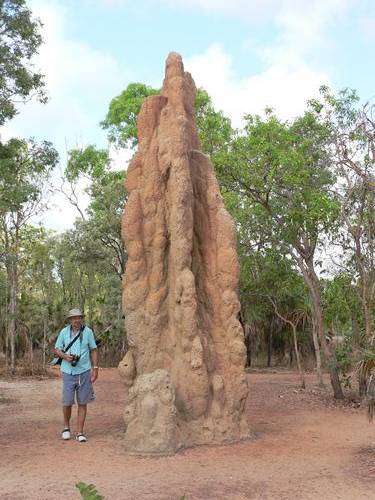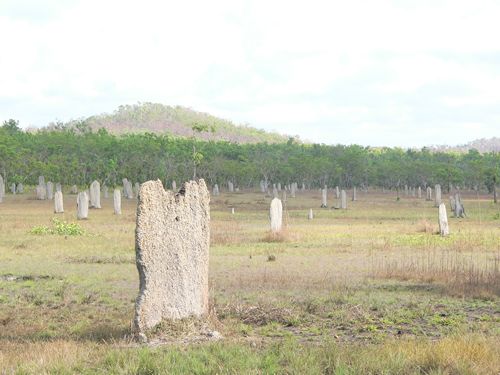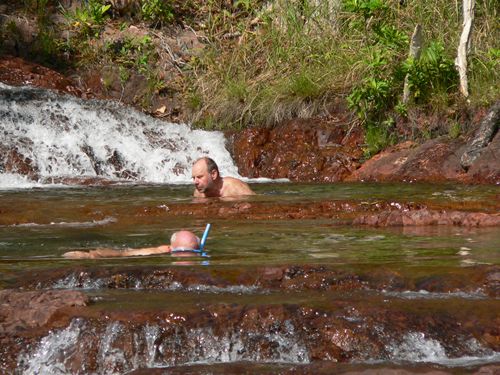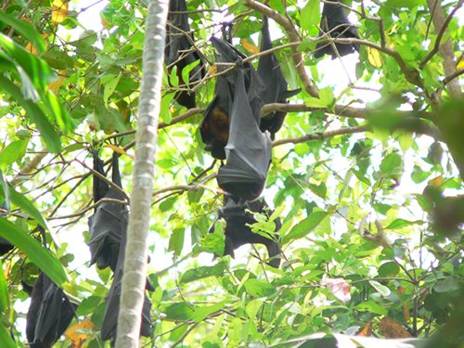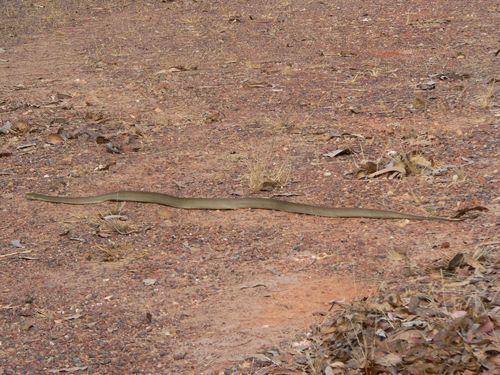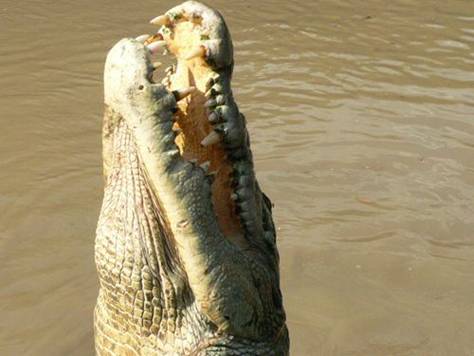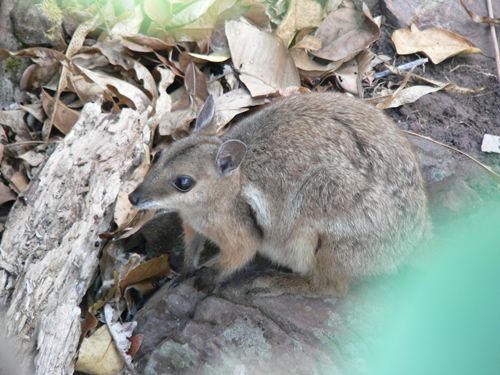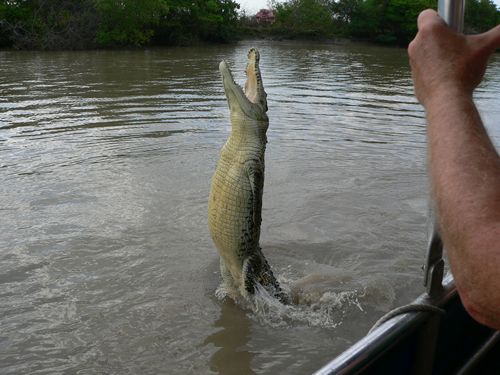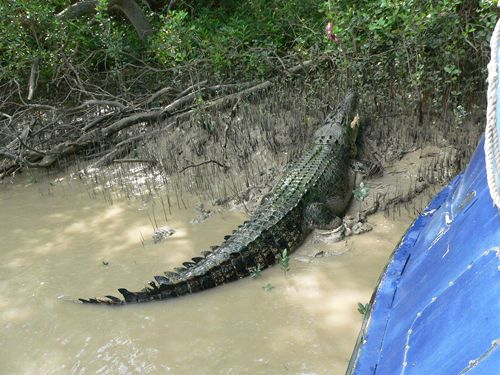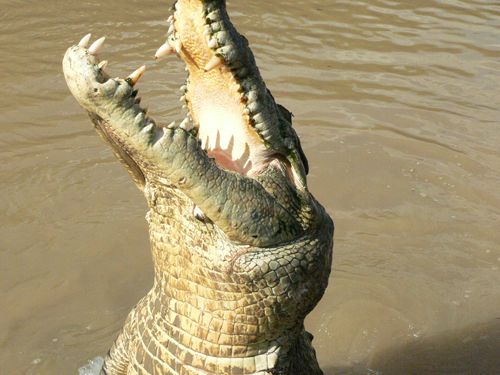Back to Nature? 2 - Litchfield and the Adelaide River

Monday 23st 2013, Timor Sea, South Indonesia 10 24.4S 123 38.3E Today's Blog by David (Time zone BST +7.00; UTC +8.0) Now is the time of the SE Monsoon (only 2 seasons here too; NW Monsoon and SE Monsoon). IN the SE Monsoon, we are promised a reliable SE15-20 knots all the way – but it hasn’t materialised. The wind has been consistently light, 5-10 knots – and consistently from the West and mainly WSW Nonetheless, we have sailed/motor sailed when we could and motored when we couldn’t and have made steady progress towards Indonesia, on passage to Kupang in Timor. We are now about 5 miles off the coast of Timor, motoring again/still, westward into 3 knots of wind from the W. We can smell the smoke from burning rubbish already. The journey is only 500 miles or so and so motoring is no problem in itself – we have plenty fuel. That the winds are not what were forecast though is a problem because, although our departure from Bali is nearly three weeks away (and clearly I can’t extrapolate the conditions that far ahead), what I do know is that we do not have enough fuel capacity to motor all the way to Mauritius!! Ho hum! Back to Nature Last Sunday we did our second tour, this time to Litchfield National Park, the Adelaide River, an Aborigine meeting place and the Charles Darwin National Park. This involved rather more of the Stuart Highway than Corroboree and was a much longer day. Our guide was Neville, or “Nifty” as he, understandably, preferred to be called. He was balanced and informative and more quietly self- assured than Simoan. We had a good day. First up was to learn about Termites. There are umpty* different kinds of termite – hundreds - but only a handful do the damage to wood/trees houses that you read about. They are perceived as ‘good’ and play a fundamental part of the ecosystem recycling decaying plant matter and putting nitrogen back into the soil. They build their mounds from dirt excrement and spit in which they live and store rotting plant matter for food. (The usual Queen bee, worker drone and soldier hierarchy). The “Cathedral” termites build mounds … like cathedrals. The gain height at about 5-10 cm per annum so this 6 metre (Terry is about 2 metres tall) is 60-100 years old – and contains several million termites stretching as far underground as above.
This mound is built in woodlands and is sheltered from the Sun by the canopy. The buttresses add surface area to allow heat to escape. Were it not so shaded, the poor little termites living above ground level would get too hot and die. In the wetlands, neither of these solutions work. There is no canopy and those termites living below ground level get to drown. So they learned to build thin and wide mounds oriented EW presenting minimum area to the sunlight – they look like grave stones lined up in an expansive grave yard:
The EW Orientation is believed to be based upon termites being able to sense the Earth’s magnetic field and so these are called “Magnetic Termites”, although it seems to me more plausible that they would be able to tell where the sun rises and sets? From there to the Litchfield National park proper where - at about 09.00AM we were invited to swim:
…..an offer not all of us took up … this being crocodile country We then went exploring finding amongst other things a 2 metre Python, fruit bats, a spider and a Rock Wallaby. Can you boys and girls at home tell which one is which?
Ooops, my mistake:
Which brings me on to the Adelaide River where we went to enjoy the spectator sport “Jumping Crocodiles”. This comprises driving around in an open sided aluminium launch looking for Crocodiles. When we find one they hold out a bit of meat above the water and the crocodile jumps out and eats it. Thus:
Please do not try this at home. These crocodiles are wild. However, they do these trips four times a day and over time, the crocs have learned to recognise the pitch of the prop of the boats that feed them; if they are hungry, they slip off the bank and come out for food. Having had to search hard to find one in the wetlands, 10-12 swam out towards the boat as it approached – and this was just those who were hungry. The jumping croc pictured here is about 3 metres long – plenty big enough to eat you all up. [Indeed, fuelled by not a little alcohol, a youth accepted a dare a couple of weeks ago to swim across the nearby Mary River. He got across OK, but on the journey back it was reported by his friends that he was last seen in the jaws of a crocodile – missing presumed dead. And some of you think this sailing lark is dangerous….?. ] It’s a tough life being a crocodile. All sorts of creatures eat the eggs including other crocodiles, and crocodiles eat other crocodiles; only about one in 30 expect to reach adulthood when they become targets for hunters who want their skin. Crocodiles were an endangered species in the early 1970s. They guessed that there then were less than 500 breeding pairs left in the Top End when Australia grew the first signs of a conscience and protected them. A big Estuarine Crocodile (as “Salties” should be known) is 6 or 7 metres with skeletons as big as 10 metres having been unearthed. Most crocodiles today, having been born since 1976, are 3.5 metres or less. There are now hundreds of thousands of these around the creeks of the Top End where you swim at your peril. [Couldn’t get anyone to dive under our boat in Cairns Marina – too big a risk]. Occasionally they find a big one. This one was 6-7 metres and our friendly skipper had led him onto the bank with a bit of food on a string.
Well, I don’t know whether crocodiles have brains that can bear grudges but I don’t want to be around to find out. We were on the boat while this 6/7 metre croc was being baited; when they eventually coaxed him back into the stream, he was a reluctant jumper, and when he did he crashed into the boat just under our feet. All these teeth (and he does seem to have had some extractions over the years) were less than four feet from my feet.
Frankly ….. I was glad when it was over! From there to a 40 minute interaction with an Aborigine teenager – an interesting cultural mix having learnt the traditional bush skills but now living in a ‘normal’ brick house with a yard and at University studying tourism. She showed us plant that are used for different purposes; medicines, pigments clothes etc. By far the most striking advice was that Mosquitoes do not like the smell of dried sweat, so to avoid mosquito bites …. Don’t wash! Then finally to a very small exhibition in some WWII Ammunition stores in Charles Darwin National Park which described the Pacific war and the fantastic rate at which China expanded its Empire in the six months following Pearl Harbour. I had no idea that they had already annexed Korea, much of Manchuria and other parts of China (Including Shanghai and Beijing) in the late 1930s and so their expansion was just part of a natural course of an on-going activity from their point of view. It was very interesting. Well that its it. We are about 4 hours from Kupang, it’s my watch, I should be on deck and Peter has just turned the engine off and we are sailing. HOORAY! xxxxxxxxxxxx0000000000000000xxxxxxxxxxxxxx *Note – Which reminds me, there is a town /village on the Stuart Highway called Humpty Doo. We never got to stop at the “Humpty Doo Tavern and Guest House” however. |
